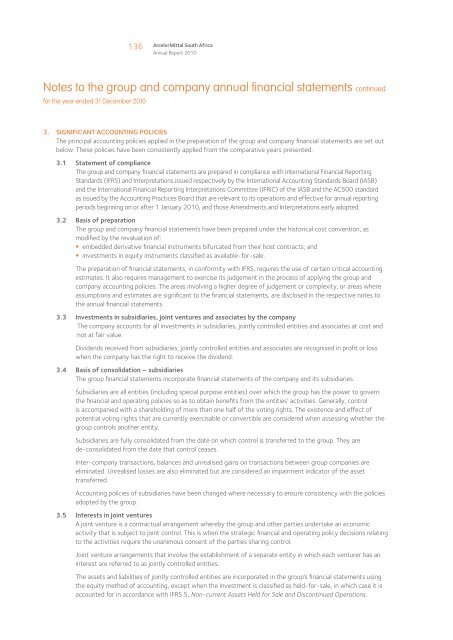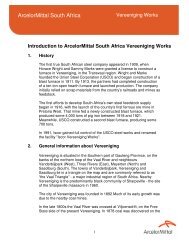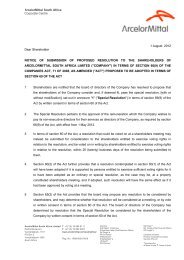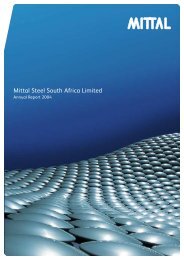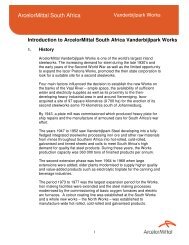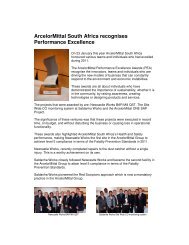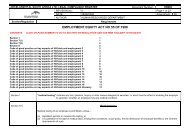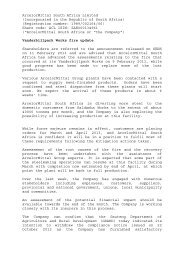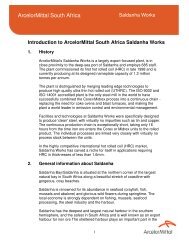bold spirit - ArcelorMittal South Africa
bold spirit - ArcelorMittal South Africa
bold spirit - ArcelorMittal South Africa
You also want an ePaper? Increase the reach of your titles
YUMPU automatically turns print PDFs into web optimized ePapers that Google loves.
136<br />
<strong>ArcelorMittal</strong> <strong>South</strong> <strong>Africa</strong><br />
Annual Report 2010<br />
Notes to the group and company annual financial statements continued<br />
for the year ended 31 December 2010<br />
3. SIGNIFICANT ACCOUNTING POLICIES<br />
The principal accounting policies applied in the preparation of the group and company financial statements are set out<br />
below. These policies have been consistently applied from the comparative years presented.<br />
3.1 Statement of compliance<br />
The group and company financial statements are prepared in compliance with International Financial Reporting<br />
Standards (IFRS) and Interpretations issued respectively by the International Accounting Standards Board (IASB)<br />
and the International Financial Reporting Interpretations Committee (IFRIC) of the IASB and the AC500 standard<br />
as issued by the Accounting Practices Board that are relevant to its operations and effective for annual reporting<br />
periods beginning on or after 1 January 2010, and those Amendments and Interpretations early adopted.<br />
3.2 Basis of preparation<br />
The group and company financial statements have been prepared under the historical cost convention, as<br />
modified by the revaluation of:<br />
• embedded derivative financial instruments bifurcated from their host contracts; and<br />
• investments in equity instruments classified as available-for-sale.<br />
The preparation of financial statements, in conformity with IFRS, requires the use of certain critical accounting<br />
estimates. It also requires management to exercise its judgement in the process of applying the group and<br />
company accounting policies. The areas involving a higher degree of judgement or complexity, or areas where<br />
assumptions and estimates are significant to the financial statements, are disclosed in the respective notes to<br />
the annual financial statements.<br />
3.3 Investments in subsidiaries, joint ventures and associates by the company<br />
The company accounts for all investments in subsidiaries, jointly controlled entities and associates at cost and<br />
not at fair value.<br />
Dividends received from subsidiaries, jointly controlled entities and associates are recognised in profit or loss<br />
when the company has the right to receive the dividend.<br />
3.4 Basis of consolidation – subsidiaries<br />
The group financial statements incorporate financial statements of the company and its subsidiaries.<br />
Subsidiaries are all entities (including special purpose entities) over which the group has the power to govern<br />
the financial and operating policies so as to obtain benefits from the entities’ activities. Generally, control<br />
is accompanied with a shareholding of more than one half of the voting rights. The existence and effect of<br />
potential voting rights that are currently exercisable or convertible are considered when assessing whether the<br />
group controls another entity.<br />
Subsidiaries are fully consolidated from the date on which control is transferred to the group. They are<br />
de-consolidated from the date that control ceases.<br />
Inter-company transactions, balances and unrealised gains on transactions between group companies are<br />
eliminated. Unrealised losses are also eliminated but are considered an impairment indicator of the asset<br />
transferred.<br />
Accounting policies of subsidiaries have been changed where necessary to ensure consistency with the policies<br />
adopted by the group.<br />
3.5 Interests in joint ventures<br />
A joint venture is a contractual arrangement whereby the group and other parties undertake an economic<br />
activity that is subject to joint control. This is when the strategic financial and operating policy decisions relating<br />
to the activities require the unanimous consent of the parties sharing control.<br />
Joint venture arrangements that involve the establishment of a separate entity in which each venturer has an<br />
interest are referred to as jointly controlled entities.<br />
The assets and liabilities of jointly controlled entities are incorporated in the group’s financial statements using<br />
the equity method of accounting, except when the investment is classified as held-for-sale, in which case it is<br />
accounted for in accordance with IFRS 5, Non-current Assets Held for Sale and Discontinued Operations.


